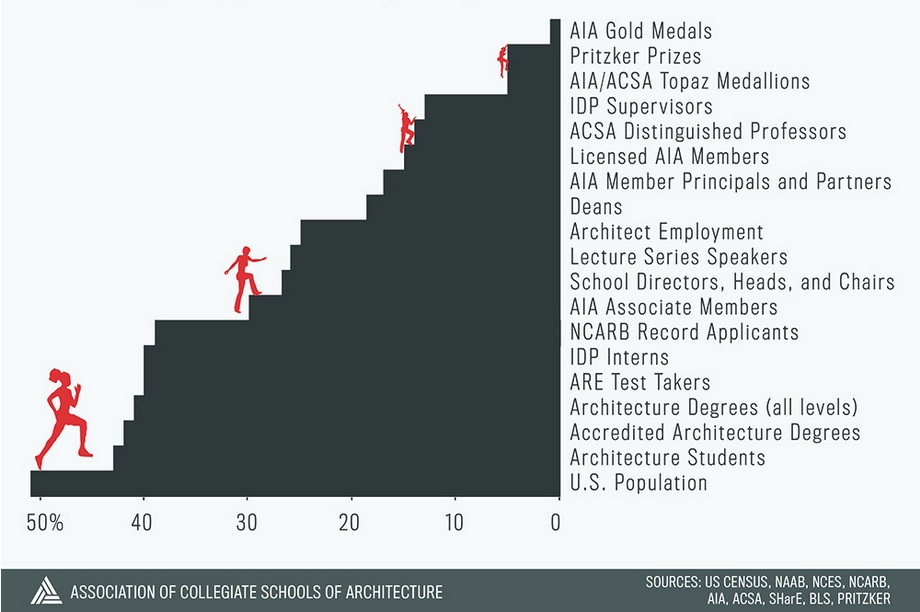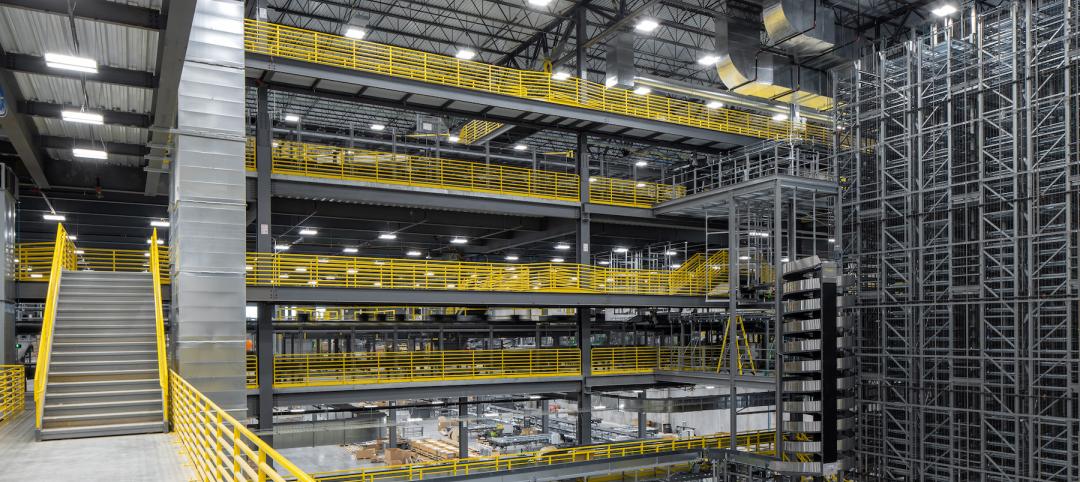Women account for more than half of the U.S. population. But even with significant gains over the past 25 years, their numbers and positions among the ranks of practicing architects appear to have stalled.
The reasons could be a combination of too few role models, mentors, and advancement opportunities, based to a statistical analysis of women’s progress in this field by the Association of Collegiate Schools of Architecture (ACSA).
Looking at recent data from a wide range of sources—including the Bureau of Labor Statistics, AIA, National Architectural Accrediting Board, the National Center for Education Statistics, and the National Council for Architectural Registration Boards—the association found that while the number of female architectural students and graduates has stabilized at around 40%, the number of women working in architect roles has also stopped increasing, and hasn’t gone much higher than 25%.
Indeed, AIA’s Foresight Report indicated that, in 2011 (the latest year for which data were available), only 30% of its women members were associates in their firms, and only 17% were principals or partners. In fact, just 15% of AIA’s licensed members were women that year. And a mere 13% of Intern Development Program supervisors, who review the work of intern architects submitting IDP hours, were female.
“Even with a sizable margin of error it is clear that there are far fewer women in practice than in school,” said Lian Chikako Chang, ACSA’s Director of Research and Information, who authored this report.
The reasons why this “leaky pipeline” persists, however, are less clear.
While Chang doesn’t state this outright, the perception of women architects as second-class citizens might have its roots in academia, where only around one quarter of lecturers, directors, heads and chairs of U.S. architectural schools are female, and only 19% of deans.
It could also be argued that women are leaving the profession at higher rates than men because they are discouraged by the lack of industry recognition their work receives. Only 5% of all TOPAZ Medallion recipients have been women, and about the same percentage of Pritzker Prize winners. Since 1907, only one of the 69 AIA Gold Medals has been awarded to a woman, and that was posthumously in 2014.
“With the share of awards going to women increasing by about 5% each decade, if we continue at this pace we’ll be waiting until 2080 to see a 50-50 split,” Chang notes sardonically.
While the author offered no specific prescriptions, Chang asserted that a more systematic approach to professional development will be required in order to encourage and support women in progressing and achieving as architects at rates more equal to those of men.
“The data reviewed here suggest that we should focus particularly on two areas: first, what happens before applying to and enrolling in architecture school; and second, what happens at higher levels in the profession, academia, and related practices,” she said.
Related Stories
Giants 400 | Oct 22, 2021
2021 Industrial Sector Giants: Top architecture, engineering, and construction firms in the U.S. industrial buildings sector
Ware Malcomb, Clayco, Jacobs, and Stantec top BD+C's rankings of the nation's largest industrial buildings sector architecture, engineering, and construction firms, as reported in the 2021 Giants 400 Report.
| Oct 22, 2021
The Next Chapter For 147-Year-Old Shepley Bulfinch
Boston-based architecture, planning, and interior design firm Shepley Bulfinch recently named Angela Watson, FAIA, as its President and CEO. Watson sat down with BD+C's John Caulfield to discuss her strategic plan, which emphasizes perspective and collaboration.
Giants 400 | Oct 22, 2021
2021 Airport Sector Giants: Top architecture, engineering, and construction firms in the U.S. airport facilities sector
AECOM, Hensel Phelps, PGAL, and Gensler top BD+C's rankings of the nation's largest airport sector architecture, engineering, and construction firms, as reported in the 2021 Giants 400 Report.
Giants 400 | Oct 22, 2021
2021 Sports Facilities Giants: Top architecture, engineering, and construction firms in the U.S. sports and recreation facility sector
AECOM, Populous, Kimley-Horn, and HOK top BD+C's rankings of the nation's largest sports and recreation facility sector architecture, engineering, and construction firms, as reported in the 2021 Giants 400 Report.
Multifamily Housing | Oct 21, 2021
Chicago’s historic Lathrop public housing complex gets new life as mixed-income community
A revitalized New Deal–era public housing community in Chicago brings the Garden City movement of yesteryear into the 21st century.
Sponsored | BD+C University Course | Oct 15, 2021
7 game-changing trends in structural engineering
Here are seven key areas where innovation in structural engineering is driving evolution.
| Oct 14, 2021
The future of mass timber construction, with Swinerton's Timberlab
In this exclusive for HorizonTV, BD+C's John Caulfield sat down with three Timberlab leaders to discuss the launch of the firm and what factors will lead to greater mass timber demand.
Multifamily Housing | Oct 12, 2021
Affordable and sublime: 13 projects that represent the future of affordable housing
These projects prove that it’s possible to develop aesthetically pleasing, high-quality housing for low-income families, the homeless, and veterans.
Building Owners | Oct 12, 2021
6 ways building owners can own their construction projects
Building owners have an important role in executing their capital projects and can greatly increase their project’s chances of success by understanding and actively managing a few key factors.
AEC Tech Innovation | Oct 7, 2021
How tech informs design: A conversation with Mancini's Christian Giordano
Mancini's growth strategy includes developing tech tools that help clients appreciate its work.
















